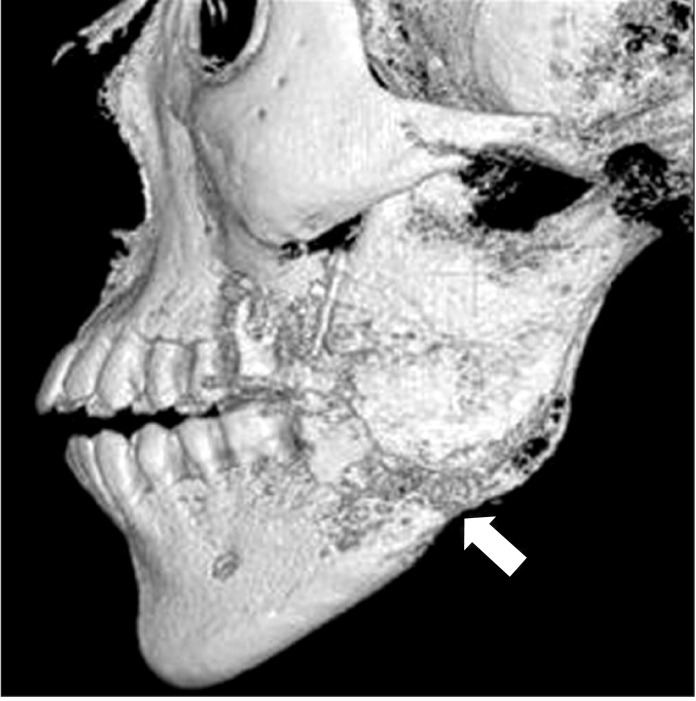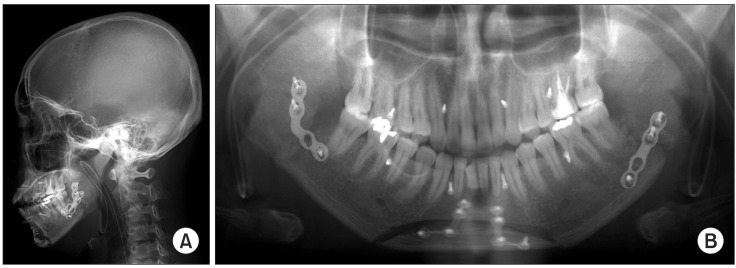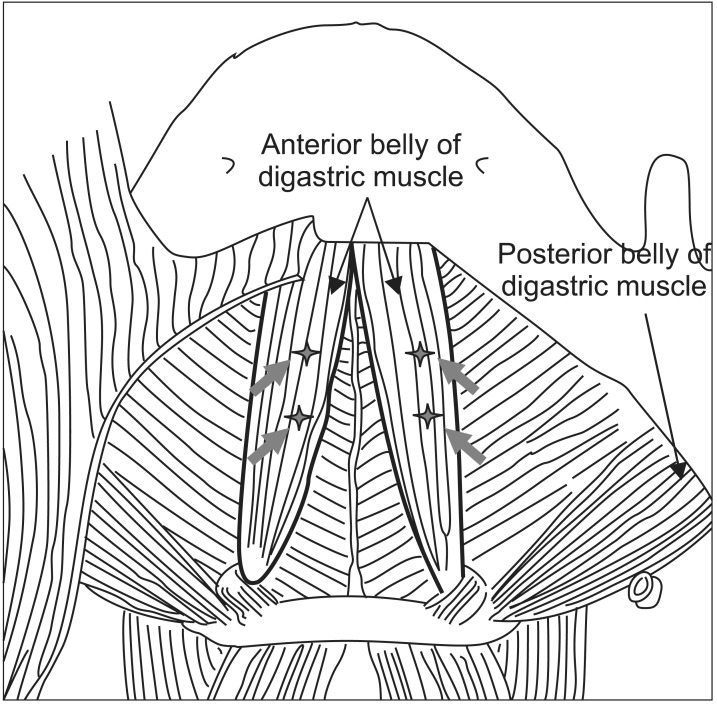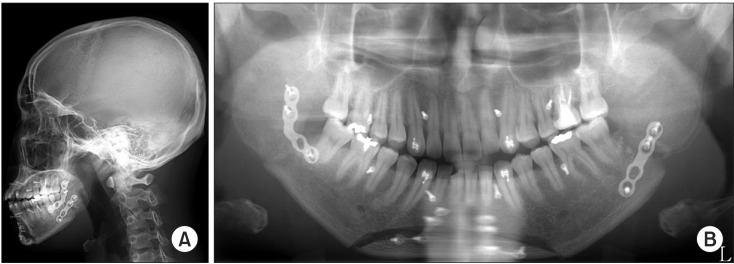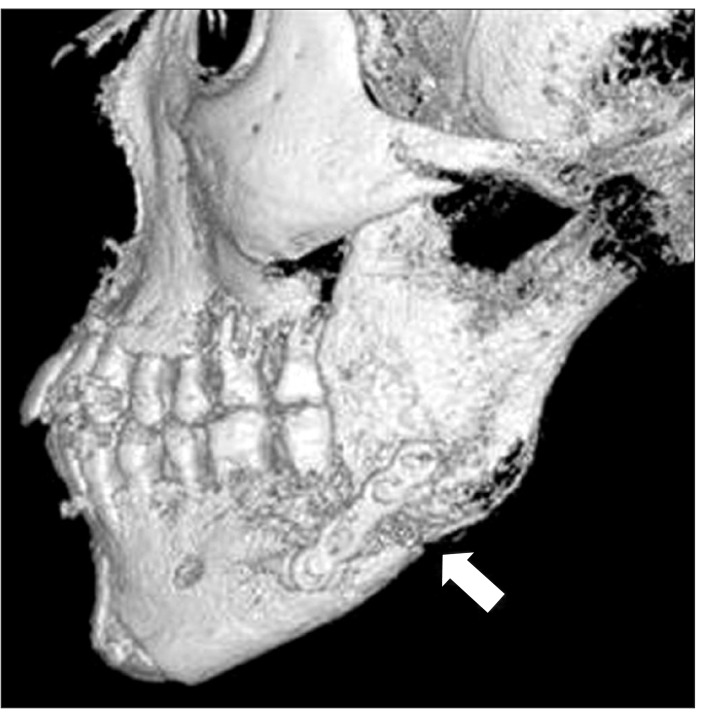J Korean Assoc Oral Maxillofac Surg.
2013 Aug;39(4):188-192.
Correction of post-traumatic anterior open bite by injection of botulinum toxin type A into the anterior belly of the digastric muscle: case report
- Affiliations
-
- 1Department of Oral and Maxillofacial Surgery, College of Dentistry, Gangneung-Wonju National University, Gangneung, Korea. sok8585@hanmail.net
Abstract
- Post-traumatic anterior open bite can occur as a result of broken balance among the masticatory muscles. The superior hyoid muscle group retracts the mandible downward and contributes to the anterior open bite. Denervation of the digastric muscle by injection of botulinum toxin type A (BTX-A) can reduce the power of the digastric muscle and help to resolve the post-traumatic anterior open bite. A patient with a bilateral angle fracture had an anterior open bite even after undergoing three operations under general anesthesia and rubber traction. Although the open bite showed some improvement by the repeated operation, the occlusion was still unstable six weeks after the initial treatment. To eliminate the residual anterior open bite, BTX-A was injected into the anterior belly of the digastric muscle. Following injection of BTX-A, the anterior open bite showed immediate improvement. Complication and relapse were not observed during follow-up. Long-standing post-traumatic open bite could be successfully corrected by injection of BTX-A into the anterior belly of the digastric muscle without complication.
Keyword
MeSH Terms
Figure
Reference
-
1. Haskell R. Applied surgical anatomy. In : Williams JL, editor. Rowe and Williams' maxillofacial injuries. 2nd ed. Edinburgh: Churchill Livingstone;1994. p. 12–14.2. Lamphier J, Ziccardi V, Ruvo A, Janel M. Complications of mandibular fractures in an urban teaching center. J Oral Maxillofac Surg. 2003; 61:745–749. PMID: 12856243.
Article3. Duchen LW. Changes in motor innervation and cholinesterase localization induced by botulinum toxin in skeletal muscle of the mouse: differences between fast and slow muscles. J Neurol Neurosurg Psychiatry. 1970; 33:40–54. PMID: 4907278.
Article4. Angaut-Petit D, Molgó J, Comella JX, Faille L, Tabti N. Terminal sprouting in mouse neuromuscular junctions poisoned with botulinum type A toxin: morphological and electrophysiological features. Neuroscience. 1990; 37:799–808. PMID: 1701041.
Article5. Morbiato L, Carli L, Johnson EA, Montecucco C, Molgó J, Rossetto O. Neuromuscular paralysis and recovery in mice injected with botulinum neurotoxins A and C. Eur J Neurosci. 2007; 25:2697–2704. PMID: 17561839.6. Landes CA, Lipphardt R. Prospective evaluation of a pragmatic treatment rationale: open reduction and internal fixation of displaced and dislocated condyle and condylar head fractures and closed reduction of non-displaced, non-dislocated fractures. Part I: condyle and subcondylar fractures. Int J Oral Maxillofac Surg. 2005; 34:859–870. PMID: 15979851.7. Ferguson JW, Stewart IA, Whitley BD. Lateral displacement of the intact mandibular condyle. Review of literature and report of case with associated facial nerve palsy. J Craniomaxillofac Surg. 1989; 17:125–127. PMID: 2651482.8. Satoh K, Suzuki H, Matsuzaki S. A type II lateral dislocation of bilateral intact mandibular condyles with a proposed new classification. Plast Reconstr Surg. 1994; 93:598–602. PMID: 8115519.
Article9. Ellis E 3rd, Walker LR. Treatment of mandibular angle fractures using one noncompression miniplate. J Oral Maxillofac Surg. 1996; 54:864–871. PMID: 8676232.
Article10. Ellis Edward III. Rigid versus nonrigid fixation. In : Miloro Michael, editor. Peterson's oral and maxillofacial surgery. 2nd ed. Hamilton: BC Decker Inc;2004. p. 371–373.11. Bérzin F. Electromyographic analysis of the sternohyoid muscle and anterior belly of the digastric muscle in jaw movements. J Oral Rehabil. 1995; 22:463–467. PMID: 7636618.
Article12. Widmalm SE, Lillie JH, Ash MM Jr. Anatomical and electromyographic studies of the digastric muscle. J Oral Rehabil. 1988; 15:3–21. PMID: 3162258.
Article13. Celik H, Yilmaz E, Atasever A, Durgun B, Taner D. Bilateral anatomical anomaly of anterior bellies of digastric muscles. Kaibogaku Zasshi. 1992; 67:650–651. PMID: 1462758.14. Carlson DS, Ellis E 3rd, Dechow PC, Nemeth PA. Short-term stability and muscle adaptation after mandibular advancement surgery with and without suprahyoid myotomy in juvenile Macaca mulatta. Oral Surg Oral Med Oral Pathol. 1989; 68:135–149. PMID: 2780014.
Article15. Choi SS, Rotaru H, Kim SG. Treatment of post-traumatic open bite by radiofrequency. Br J Oral Maxillofac Surg. 2007; 45:311–313. PMID: 16406179.
Article16. Tan EK. Oromandibular dystonia. In : Mitchell FB, editor. Dystonia: etiology, clinical features, and treatment. Philadenphia: Lippincott Williams & Wilkins;2004. p. 171–172.
- Full Text Links
- Actions
-
Cited
- CITED
-
- Close
- Share
- Similar articles
-
- Screening for variations in anterior digastric musculature prior to correction of post-traumatic anterior open bite by injection of botulinum toxin type A: a technical note
- Botulinum toxin-A injection into the anterior belly of the digastric muscle for the prevention of post-operative open bite in class II malocclusions: a case report and literature review
- Botulinum toxin A injection into the anterior belly of the digastric muscle increased the posterior width of the maxillary arch in developing rats
- A clinical perspective on the anatomical study of digastric muscle
- Accessory Heads of Anterior Belly of Digastric Muscle in Korea

